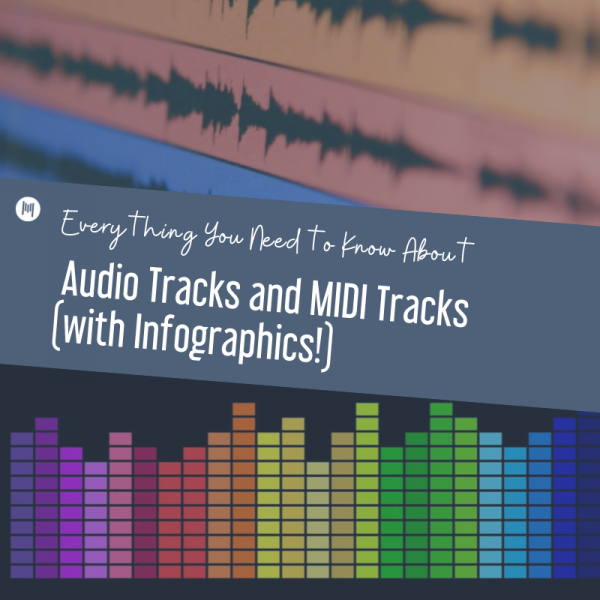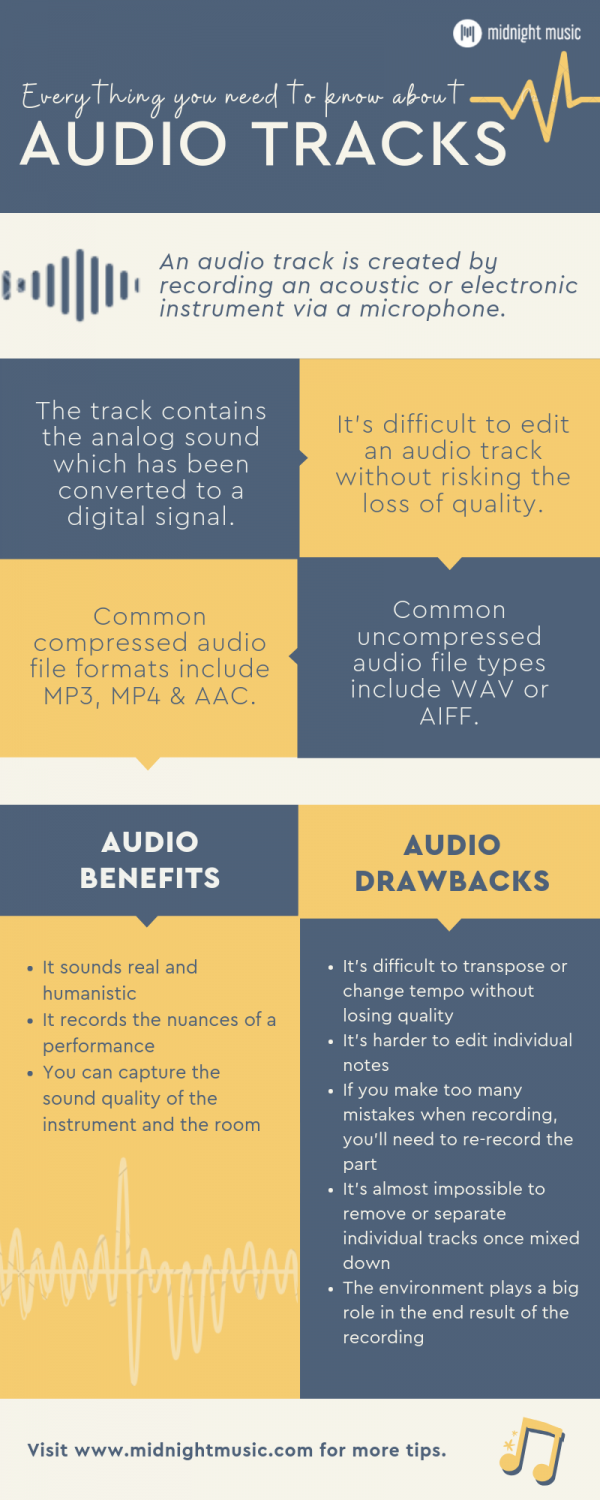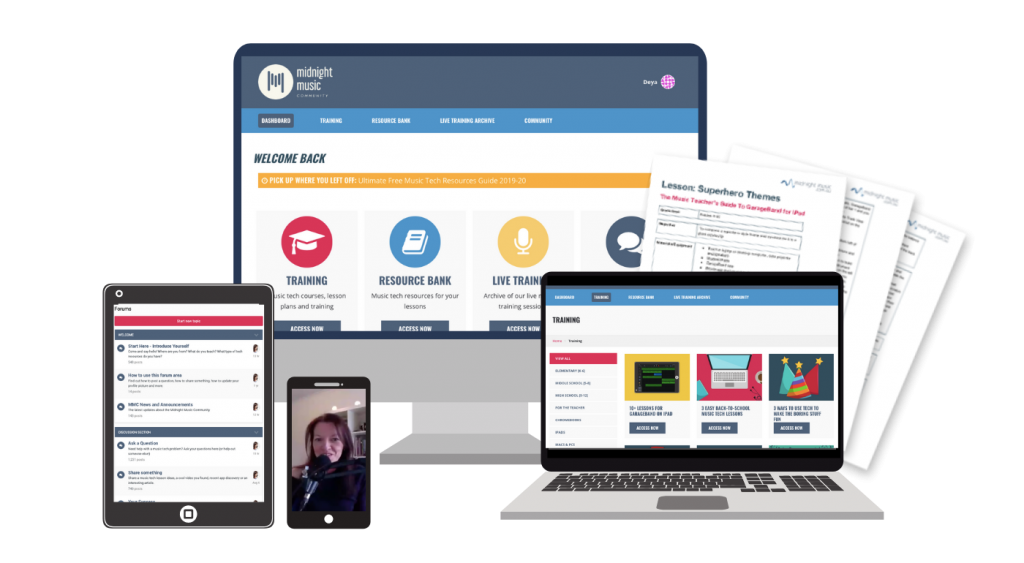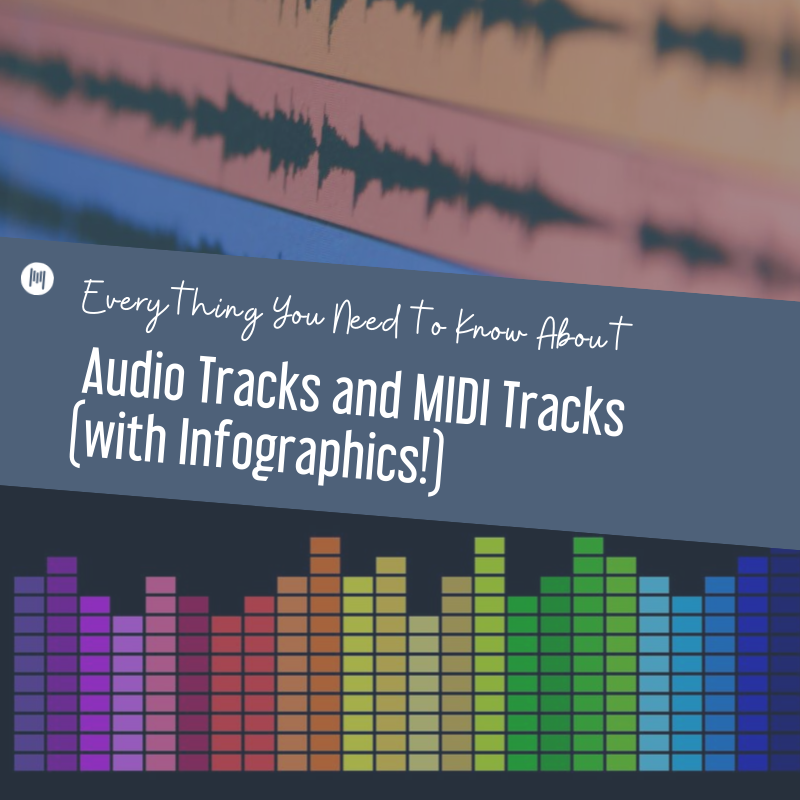
When using a Digital Audio Workstation (DAW) like GarageBand, Soundtrap or Bandlab you can record two types of tracks:
- A software instrument track (MIDI)
- A live musician playing or singing (audio)
If you’re thinking to yourself that Audio vs MIDI is a dry topic, I would strongly beg to differ. Understanding these two file types is crucial as a music teacher and is extremely useful. That’s why in this blog post we’ll talk all about how understanding these file types properly can help you make backing tracks, notate music and shortcut the entering of notes into music software, which in turn will of course speed up productivity.
First, let’s dive into MIDI tracks.
About MIDI Tracks

- A MIDI track is created by a software instrument
- The track contains data about notes and playback sound
- MIDI stands for Musical Instrument Digital Interface
- It’s easy to edit notes on a MIDI track
- A MIDI file ends with .MID
- MIDI file makes no sound. It simply tells the software what to play and how to play it, the same way a pianola roll tells a pianola which notes to play and how to play them
- Music file that contains information about notes: which pitch, when to play them, how to play them, velocity, length
- When you open this file with a music software program, the software knows what to play
- The software uses its own sounds to play back the file
- The file can sound different when opened in different software apps because each app has its own unique set of instruments
Easiest way to understand MIDI files:
- MIDI file is the digital version of a pianola roll.
- A pianola roll does not make any sound itself
- A pianola roll controls the pianola and tells it what to play
- The information on the pianola roll tells the pianola which notes to play, how long or short each one is and how loud or soft they are.
- You can take the pianola roll and place it inside another pianola – the note length and dynamic will be the same, but the overall tone or timbre will be different because it’s being played by a different pianola.
- A MIDI file works the same way – you import it into a software program such as GarageBand, Soundtrap, Mixcraft, Logic, ProTools, Ableton, Sibelius or Finale (the “pianola” equivalent) and it contains information about which instruments will be played, which notes they will play, how long, how loud and so on.
- A MIDI file played by GarageBand might sound a little different when played by Soundtrap because each of those programs has its own unique set of instrument sounds.
What can you do with MIDI files?
- The best thing about MIDI files? You can edit the information!
- If you don’t like the note length in the bass guitar part, just edit it.
- If you want to remove the keyboard part, select it and delete it.
- You can edit the notes in a MIDI file (make a note longer or shorter, transpose it, delete it)
MIDI files are readily available online:
- Download
- Open in your music software
- Saves you having to record all the parts separately
- Quality of ones you find online are varied – inaccuracies, mechanical
- But you can edit it
- Can use them as a shortcut to entering notes into your software
Benefits of MIDI Tracks
- You can easily change individual notes: pitch, duration, velocity
- You can switch playback sound instantly
- You can record instruments that you don’t own
- You can transpose or alter the tempo without losing quality
- You can easily separate individual parts
- You don’t need a quiet environment to create a MIDI track – you can record anywhere, anytime
Drawbacks of MIDI Tracks
- MIDI can lack a “human” touch
- It can sound mechanical
- MIDI relies on the quality of sounds in your software program
- It’s easy to create “impossible to play” parts like a drum part that can only be played by a person with 4 arms and legs!
About Audio Tracks

- An audio track is created by recording an acoustic or electronic instrument via a microphone
- The track contains the analog sound which has been converted to a digital signal
- It’s difficult to edit an audio track without risking the loss of quality
- Common uncompressed audio file types include WAV or AIFF
- Common compressed audio file formats include MP3, MP4 & AAC
Easiest ways to understand audio tracks:
- An audio file is a recording of a real instrument or voice
- Recorded through a microphone
- “Real” instrument = live person
- Sounds real – includes breaths, sound of fingers on a fretboard, has a humanistic quality, not perfect
- More difficult to fix or edit – if you make mistakes, re-record
- Produces a .WAV or .AIFF file (large in size, good quality) or a .MP3 (compressed – smaller size)
- Generally – recording is not quantized
- If the audio file you’re listening to includes more than one instrument (i.e. drums, bass, keyboard and voice) you can’t separate the tracks. It’s like baking a cake – once the cake is baked, you can’t go back and remove the eggs! This is known as the “mixed down” version or exported version
Common wishes:
- What if you want the track without vocals? For a backing track?
- Difficult to remove vocals from an audio file cleanly
- Varied results
- Some software can do it, but results will depend on how recording is mixed in the first place
- Not a good result if you need end of year performance track
- Look for commercial karaoke version or backing track
- What if you want just the vocals on their own for a remix project?
- If you want any one single instrument part from an audio file, you need to look for stems
- Can be hard to find legal versions
- Look for remix competitions
- Link in shownotes to remix stems article
- What if you want all the instrument parts in the audio file notated?
- Almost impossible
- Technology not there yet
- Some apps claim to do it – I have not seen great results yet
- Some can notate a single part – multiple parts at once – no
- Best option – develop your transcription ear-training skills
Benefits of Audio Tracks
- It sounds real and humanistic
- It records the nuances of a performance
- You can capture the sound quality of the instrument and the room
Drawbacks of Audio Tracks
- It’s difficult to transpose or change tempo without losing quality
- It’s harder to edit individual notes
- If you make too many mistakes when recording, you’ll need to re-record the part
- It’s almost impossible to remove or separate individual tracks once mixed down
- The environment plays a big role in the end result of the recording
What’s next?
- Explore MIDI files
- Download and import into software
- Play around with them
- You and students can save their own MIDI files
- Example of use: Groove Pizza – download MIDI file version of pattern, import into another program so you can change the sounds, change the tempo, add more part
- Note: GarageBand cannot export MIDI files – use Logic
Hope that helped you understand more about audio and MIDI file types. That’s it for today’s blog post! If you have any questions, let us know in a comment below.
Download your copy
Would you like to take a copy of this with you? Click the button below and a copy of this will be sent directly into your inbox.
Looking for More Resources for Music Teachers?
Hello! I’m Katie Argyle – an Australian music technology trainer and consultant with a passion for helping music teachers through my business Midnight Music.
I’m a qualified teacher but no, I don’t currently teach in a school. I help teachers through my online professional development space – the Midnight Music Community – where there are tutorial videos, courses, links and downloadable resources.

I like to focus on easy ways to incorporate technology into what you are already doing in your music curriculum through a range of creative projects. I also run live workshops and have presented at countless conferences and other music education events.
If you want simple, effective ideas for using technology in music education, I would LOVE to help you inside the Midnight Music Community.













10 Comments
Hey Kate. I’m not a music teacher, just your ordinary ‘old’ bloke who’s beginning the journey of discovering how to use Garageband, Band in a Box, Songbook etc
I’ve struggled to understand what a MIDI file is. Your blog was just so good. I’m getting the picture!
Well done, fellow Aussie!
You’re welcome!Thanks for the kind words 🙂
[…] score, and drum editors included in the workstation. The key editor lets you manually edit your MIDI track in case you need to move a note over here and there. You get your unlimited audio and MIDI tracks, […]
[…] score, and drum editors included in the workstation. The key editor lets you manually edit your MIDI track in case you need to move a note over here and there. You get your unlimited audio and MIDI tracks, […]
[…] batería incluidos en la estación de trabajo. El editor de claves le permite editar manualmente su pista midi en caso de que necesite mover una nota aquí y allá. Obtiene sus pistas de audio y MIDI […]
[…] another. For recording virtual instruments in the studio, the MIDI keyboard is typically used. A MIDI track has a much smaller file size than a real audio track. A standard five-pin connection is used for […]
[…] not that uncommon in rock music today, but this was once revolutionary. A MIDI track can be created from the Drummer Track, and this has a number of significant advantages. In contrast […]
[…] and sounds that are typically impossible on guitar, you can use MIDI to convert your guitar to a MIDI track. You can transform a guitar into a saxophone, piano, flute, drum kit, or synthesizer, or you can […]
[…] electric piano, and string section tracks. Drag and drop the Drum Kit track onto the track for the MIDI track as part of the Drum Kit track. By dragging and dropping the Bass Guitar track onto the track for […]
[…] plugin in Ableton that is created specifically for drum beat production. You can simply drag in a MIDI track from one of their impressive drum racks to start your drum set. A drum sample can also be dragged […]